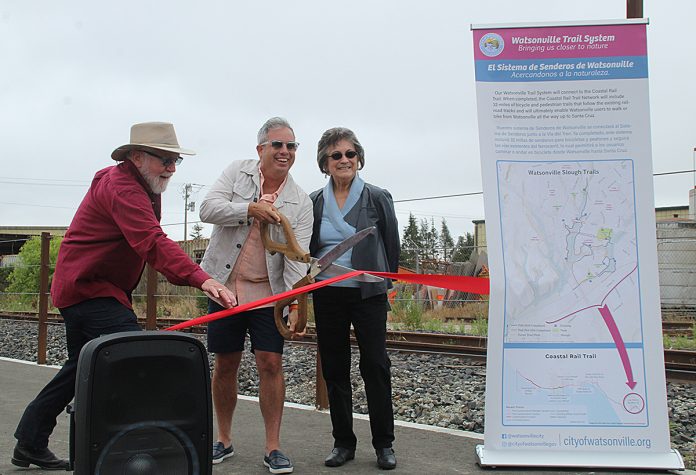WATSONVILLE—Roughly 60 people—many of them on bikes—gathered on the southwest outskirts of Watsonville on July 17 to celebrate the completion of the first phase of the city’s segment of the Coastal Rail Trail.
The ribbon-cutting for the 12-foot wide, quarter-mile-long strip of asphalt between Walker Street and Ohlone Parkway flanked by the county’s rail line featured speeches from Watsonville Mayor Jimmy Dutra, Santa Cruz Regional Transportation Commission (RTC) Executive Director Guy Preston and Watsonville Principal Engineer Murray Fontes.
It also featured a guided bike tour of the sprawling Watsonville slough trails abutting South County’s latest cycling infrastructure.
It was a ceremony some six years in the making. The trail, the 18th segment in the 20-segment Coastal Rail Trail, first received environmental approval in 2015, and the city entered into a design contract three years later. Since then, the project has been somewhat of a headache for the city and the RTC.
In 2019, design work more than doubled to $329,110 after the city split the project into two phases because it needed additional time to secure permits to install new crossings on the railroad tracks on Ohlone Parkway.
In addition, because of issues with soil and water lines, among other things, the city had to make nine changes to the construction contract with Granite Rock, adding another $638,329.31 to the original $1.45 million price tag.
Much like the construction of the trail, the ceremony had its hiccups. A tall, thin display of the trail was knocked over by a strong gust of wind and lightly hit Dutra on the back of his head. Also, the portable speaker system stopped working midway through the ceremony, and the extra-large ceremonial scissors failed to cut through the red ribbon before someone with a switchblade came over and saved the day.
Still, all on hand were mostly joyous about the trail’s completion, and civic leaders were bullish about the future of the project. Fontes highlighted how the city’s segment would connect to both the Watsonville slough trail system and also Pajaro Valley High School on the northwest side of the city many years down the road. He also touted the 32-mile Coastal Rail Trail and greater 50-mile Monterey Bay Sanctuary Scenic Trail Network that will span the entire Santa Cruz County.
“I hope when you look at this trail, I hope you don’t just see an isolated quarter-mile,” Fontes said. “I hope you see the start of something bigger.”
Design on the second half of Watsonville’s trail segment is expected to be completed sometime next year, and construction will begin shortly after.
The city of Santa Cruz also completed a segment of the Coastal Rail Trail last year, and other segments are in various development stages.
The project recently turned into a confusing, countywide kerfuffle between those for and against a passenger rail line. Advocates envision a convenient, environmentally-friendly transportation alternative that could connect the county and give daily commuters another resource. Opponents see an unsightly, expensive untenable behemoth incompatible with the county that is unlikely to reduce Highway 1 traffic congestion.
RTC staff has said that it will continue to search for the $17 million needed to fund an environmental review for passenger rail plans to move forward.








